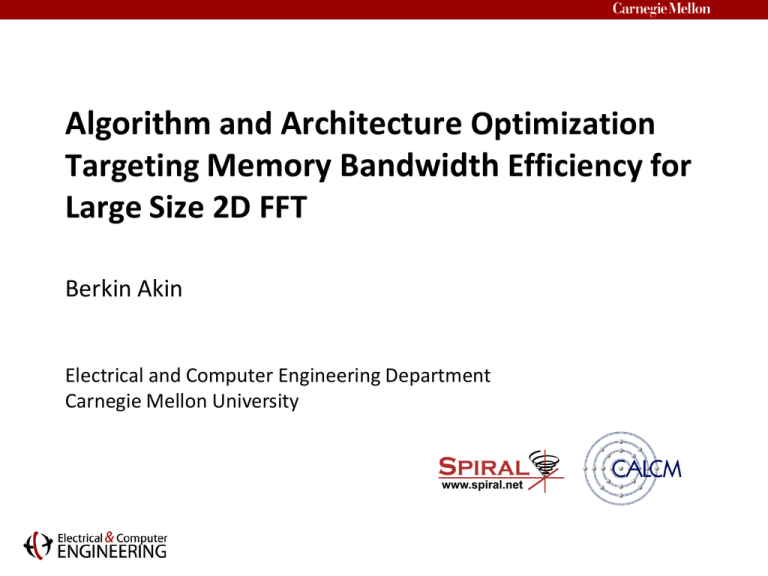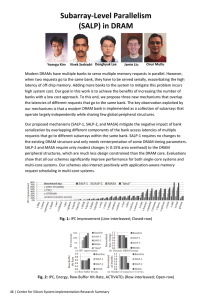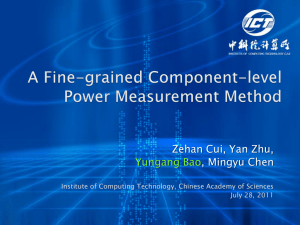Algorithm Architecture Memory Bandwidth
advertisement

Algorithm and Architecture Optimization Targeting Memory Bandwidth Efficiency for Large Size 2D FFT Berkin Akin Electrical and Computer Engineering Department Carnegie Mellon University The “Memory Wall” “Growing gap between on-chip processing throughput and off-chip memory bandwidth” “Pin counts increase at rate of 10% per year in contrast to doubling transistor densities every 18 months” - International Technology Roadmap for Semiconductors (ITRS) Memory bandwidth becomes the bottleneck Efficient use of memory bandwidth should be first class design consideration 2 Application: Large 2D-FFT on FPGA Important computational kernel in scientific computing, signal processing Solving PDEs SAR CT Typical datasets are large and high precision 2K-by-2K double precision 2D-FFT: Input dataset: 64 MB # of operations: 461 Mflops Data is stored off-chip in DRAM Conventional algorithms do not have efficient DRAM access patterns 3 Design Goals and Approach Design goals Performance Bandwidth efficiency Power efficiency Algorithm and architecture optimization Efficient DRAM access patterns Maximum computation throughput Balanced architecture Scalable and parameterized hardware H.T. Kung, “Memory requirements for balanced computer architectures,” ISCA ‘86 4 Outline Motivation Background Existing Implementations Our DRAM Optimized Design Results Conclusion 5 Discrete Fourier Transform (DFT) DFT as a matrix-vector multiplication: output vector transform matrix input vector Fast Fourier Transform (FFT) is a fast algorithm for DFT # of operations: Similarly there exists FFT algorithms for 2D-DFT 6 Fast Fourier Transform (FFT) History First discovered by Gauss in 1805 Fourier publishes in 1807 Rediscovered by Cooley-Tukey in 1965 Workload characteristics for “N-point FFT” # of arithmetic ops: 5Nlog(N) # of memory transfers: N Arithmetic intensity: 5log(N) ops per access Heideman et al, “Gauss and the History of the Fast Fourier Transform,” Arch. Hist. Sc. ‘85 Cooley and Tukey, “An algorithm for the machine calculation of complex Fourier series,” Math of Comp. ‘65 7 A 2D-FFT Algorithm C. Van Loan, “Computational frameworks for the fast Fourier transform”, SIAM ‘92 Row-column algorithm: tensor product Column Stage identity matrix DFT matrix Row Stage 1D-FFTs 1D-FFTs … … Dataset: n (Logical abstraction of the 2D dataset) n 8 DRAM Organization & Operation Commonly used off-chip storage medium Divided hierarchically into: Rank, chip, bank, row, column 9 DRAM Organization & Operation DRAM Bank Row: 14 0 1 2 3 4 5 6 7 Row Decoder DRAM addresses: 1) Row 4, Column 0 2) Row 4, Column 1 3) Row 4, Column 7 4) Row 1, Column 2 5) Row 1, Column 3 Row buffer MISS HIT Column: 3 0 1 7 2 Column Mux 10 DRAM Bandwidth Experiment on DE4 FPGA platform w/ DDR2-800 SO-DIMM “Packet” = Aligned consecutive data Transfer packets that are separated by large strides Theoretical Peak Row-column 2D-FFT: Row buffer size Row-wise 1D-FFTs Column-wise 1D-FFTs 11 Outline Motivation Background Existing Implementations Our DRAM Optimized Design Results Conclusion 12 Baseline Design I.S. Uzun, A. Amira, A. Bouridane, “FPGA implementations of fast Fourier transforms for real-time signal and image processing,” IEE Proc.-Vision, Image and Signal Processing, 2005 Off-chip problem sizes are considered Off-chip SRAMs -> No penalty for access pattern Limitations: Off-chip SRAMs are expensive 2048-by-2048 double precision 2D-FFT has 64 MB dataset Used FPGA platform has 8 MB off-chip SRAM Limited precision (16-bit fixed point) Algorithm is not efficient for platforms with DRAMs 13 DRAM Optimized Design Chi-Li Yu, K. Irick, C. Chakrabarti, V. Narayanan, “Multidimensional DFT IP generator for FPGA platforms,” IEEE Transactions on Circuits and Systems, 2011 Targets large datasets Addresses the DRAM access pattern problem Row-wise bursts by transferring multiple columns Limitations: Suboptimal memory utilization Inefficient row-buffer use Imbalanced algorithm Asymmetric stages (uneven computational load) Different size on-chip FFTs 14 Outline Motivation Background Existing Implementations Our DRAM Optimized Design Results Conclusion 15 Our Design - Overview B. Akin, P. Milder, F. Franchetti, J.C. Hoe, “Memory bandwidth efficient two-dimensional fast Fourier transform algorithm and implementation for large problem sizes,” FCCM, 2012 DRAM bandwidth is efficiently utilized Row buffer locality aware access patterns Balanced algorithm and architecture Symmetric algorithm (identical operations across stages) Off-chip bandwidth and on-chip throughput is matched Maximum computation throughput is extracted 16 Inefficient DRAM Access Patterns • Row-wise traversal -> Sequential accesses • Column-wise traversal -> Large strided accesses Dataset (Logical abstraction): … n Physical Memory: (Address space) 0 Row buffer size … n n2 17 How to Optimize the Access Patterns Dataset (Logical abstraction): … n Physical Memory: (Address space) 0 k2 k … k Row buffer size … n Row buffer size chunks (i.e. DRAM rows) n2 18 Row-Column Algorithm with Tiling Input dataset: (Logical abstraction) … Output dataset: (Logical abstraction) Row-wise FFT stage … … … n n … … … … n n On-chip … Apply FFT 19 Row-Column Algorithm with Tiling Input dataset: (Logical abstraction) n Output dataset: (Logical abstraction) Column-wise FFT stage n … … … … … … … … n n On-chip … 20 Row-Column Algorithm with Tiling DRAM access pattern problem is solved We make use of the whole row-buffer whenever we access DRAM Row-buffer misses are minimized Stages of the algorithm are not the same! Datapath can be simplified by having identical stages Design generator based on tensor formalism We can handle more complicated but more elegant algorithms Parameterized and scalable hardware Can be tuned for different memory systems 21 Design Generator w/ Tensor Formalism Column Stage Row Stage Row-column algorithm Symmetric algorithm Symmetric algorithm with tiling Write tiles Transpose column-wise and re-tile on-chip FFT processing Linearize on-chip Read tiles row-wise 22 Overall Architecture DRAMs Control Memory Controller A Control Local Memory A DRAMs Read Buffer Memory Controller B FFT Core Write Buffer Local Memory B Control Control 23 Overall Architecture Input dataset Memory Controller A Local Memory A Read Buffer Intermediate results Memory Controller B FFT Core Write Buffer Local Memory B 24 Overall Architecture Output dataset Memory Controller A Local Memory A Read Buffer Intermediate results Memory Controller B FFT Core Write Buffer Local Memory B 25 Read & Write Buffers Ensuring continuous flow of data to and from the core Compensates the bubbles in the data-flow due to DRAM Also used to monitor imbalances between read, write and compute bandwidth and to throttle up/down memory controllers if necessary 26 Maximizing the Throughput Single memory LM Core Dual memory Read Write LM Core LM Read: Compute: Write: R Read: Compute: Write: R C W R C R C W W Dual memory w/ double buffering Read Write LM LM LM Core LM Read: Compute: Write: W W W R C C C C R R R C W W Saved cycles R R R R C C C C W W W W Saved cycles 27 Implementation Details FFT Core Generated using Spiral FFT IP generator Fully pipelined, scalable throughput Local Memories Constructed out of embedded block RAMs on FPGA Double-buffered to overlap computation and data accesses Multi-banked, supports streaming permutations P. Milder et al, “Automatic Generation of Streaming Datapaths for Arbitrary Fixed Permutations,” DATE 2009 Memory controllers Altera High Performance Controller (HPC) Achieved above 90% of theoretical peak with efficient access patterns 28 Outline Motivation Background Existing Implementations Our DRAM Optimized Design Results Conclusion 29 Evaluation - I Summary of three reference works FFT Size FPGA Off-chip Memory Precision Runtime (ms) Source 1K-by-1K Virtex-E 4xSRAM 16 (fixed) 62.5 Baseline 1K-by-1K Virtex-5 1xDDR2-400 32 (single) 102.6 DRAMopt 1K-by-1K Stratix IV 2xDDR2-800 64 (double) 6.1 Ours 30 Evaluation - II Platforms: FPGA: Altera DE4 development board featuring Stratix IV FPGA CPU: Intel Core i7 960 Quad Core GPU: Nvidia GeForce GTX 480 Application: 2D-FFT of sizes up to 2,048-by-2,048 Double-precision, complex values Metrics: Raw performance (Gflop/s) Bandwidth efficiency [(Gflop/s)/(Gbyte/s)] Power efficiency [(Gflop/s)/Watt] 31 Platform Comparison DRAM Type # of Memory Channels Memory BW (GB/s) On-chip Memory (MB) Proc. Freq. (MHZ) # of PEs (Cores) Application Infrastructure Core i7 960 GTX 480 Stratix IV (DE4) EP4SGX530 DDR3 GDDR5 DDR2 3 6 2 25.6 177.4 12 8 1.69 2.53 3,200 1,401 200 4 480 N/A Spiral CUDA 4.0 Spiral/Verilog 32 Evaluation - II 33 Evaluation - II 34 Evaluation - II 35 Summary & Conclusion Memory bandwidth is a precious resource Becomes performance bottleneck Efficient use of memory bandwidth enables high performance Has to become first class design consideration Algorithm and architecture for large size 2D-FFT Memory bandwidth is efficiently utilized Computation throughput is maximized Scalable and parameterized design Outperforms existing FPGA implementations More bandwidth and power efficient than GPUs and CPUs 36 QUESTIONS? 37


